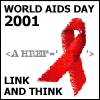
|
Saturday, July 13, 2002
|
|
| |
|
Apparently Durex Condoms will advertise anywhere they are able. Looks good I think.
10:30:29 PM 
|
|
|

|
Friday, July 12, 2002
|
|
| |
|
In a 1994 National Transportation Safety Board study it was found that "73% of all flight incidents occurred on a crew's first day of flying together, and almost half (44%) took place on a crew's very first flight." [Optimize]
This seems to be a reasonable corollary to first time sex. If you are with a partner for the first time you might be well served by studying these findings. Or at least be prepared to have the experience not be very good, or perhaps dangerous, if you haven't done the proper prep work with your partner.
12:58:09 PM 
|
|
|
Cosmopolitan had a poll last November which showed a marked decrease in condom usage among young women. The timing seems to imply a distinct effect of the events of 9/11/2001. I never had the opportunity, of course, to be with anyone back then but I can certainly see how unprotected sex might be a relief when it seems that the whole world has turned upside down. Maybe this is just a coincidence.
12:03:37 AM  Google It! Google It!
|
|
|

|
Thursday, July 11, 2002
|
|
| |
|
Semen makes you happy. That's the remarkable conclusion of a study comparing women whose partners wear condoms with those whose partners don't.
11:46:36 PM  Google It! Google It!
|
|
|
Condomi produced a condom called XXL for the UK market. The "condom is 200mm long - 20mm longer than its standard size - and 54mm across, 2mm wider than its other products". Apparently the condom has flopped, at least compared to sales in Germany, France, & Italy. In the US the largest condom is the Trojan MagnumXL. It is 205mm long while the base is 54mm and the top ballons up to 65mm.
To be sure though there is a big need, excuse the pun, for larger size condoms. The condom industry needs to produce a wider variety of sizes and give the consumer the tools needed to determine which size is best for them. There are millions of men who will pay a premium to get a proper fit. Many of those find 205mm long condoms to be too short. As in any consumer product if the producer can supply all the shades of demand they can grow the market.
Condomi's Victoria Wells believes a scientist will help convince the British to adopt their larger size condom. I maintain that you must supply the tools to discover what condom fits the user best and reflects his needs the closest. This is how you sell condoms. I don't know how Condomi framed or marketed these condoms but I do wonder.
10:53:10 PM  Google It! Google It!
|
|
|

|
Wednesday, July 10, 2002
|
|
| |
|
A research done by: The National Institute of Health (NIH), The Food and
Drug Administration (FDA), the Centers of Disease Control and Prevention
(CDC), en de US Agency for International Development (USAID), July 2001 -
Unfortunately, too many experts seem to obfuscate, to create a confusing
haze around the reality of condoms. The facts though, are rather clear. The
National Institutes of Health last year convened a panel to explore the
scientific evidence determining whether male latex columns are effective in
preventing sexually transmitted diseases (STD) - the report has just been
released. Experts from around the world presented research to the panel.
What the panelists heard paints a much less reassuring picture about
condoms than the message kids and parents generally hear.
The panel found that condoms can reduce the risk of HIV by approximately 87
percent if they are used 100 percent of the time. Condoms can reduce the
risk of gonorrhea in men, and may or may not reduce the risk of chlamydia
in men. (Chlamydia is an STD that is a common cause of infertility in women
and is common in sexually active adolescents.) The studies reviewed
consistently reported that condoms had no impact on the risk of sexual
transmission of human papillomavirus (HPV) infection in women, which is
responsible for more than 98 percent of cervical cancers. Finally, they
learned that there is no clear evidence that condoms reduce the risk of any
other STD, including gonorrhea and chlamydia in women and HPV infection in men.
Download and read the NIH report:
Greetings,
Mrs. Marian van Hofslot.
10:43:56 PM  Google It! Google It!
|
|
|
With the recent announcement from the CDC that spermicide is to be avoided I wonder how long it will be before the US government refrains from buying spermicide?
Me thinks soon. {wink}
10:11:36 PM 
|
|
|
Todd Hertz, for Christianity Today, writes that "Because abstinence programs are relatively new compared to risk-reduction or reproductive biology curriculums, there is less research available on them."
This is true. There is not nearly enough education and research in sexuality and health.
"But there is ample evidence for abstinence programs' effectiveness, according to Heritage Foundation senior research fellow Robert Rector. In April, he wrote a report detailing the scientific evaluations of ten abstinence-only programs. Such curriculums, he concluded, "have repeatedly been shown to be effective in reducing sexual activity among their participants."
This is great! The more methods that work to slow the spread of disease and heartache the better. As long as one choice does not disallow another choice everyone should be happy.
"A 2001 study published in the American Journal of Sociology found that teens who make virginity pledges stay virgins 18 months longer than those who do not."
"A study commissioned by Focus on the Family is due next year."
Rector writes, in The Effectiveness of Abstinence Education Programs in Reducing Sexual Activity Among Youth, "Not only do such programs, by their very nature, minimize the abstinence component of sex education, but many of these programs also implicitly encourage sexual activity among the youths they teach. Guidelines developed by SEICUS, for example, include teaching children aged five through eight about masturbation and teaching youths aged 9 through 12 about alternative sexual activities such as mutual masturbation, "outercourse," and oral sex. 16 In addition, the SEICUS guidelines suggest informing youths aged 16 through 18 that sexual activity can include bathing or showering together as well as oral, vaginal, or anal intercourse, and that they can use erotic photographs, movies, or literature to enhance their sexual fantasies when alone or with a partner. Not only do such activities carry their own risks for youth, but they are also likely to increase the incidence of sexual intercourse."
This seems to be pretty accurate for how the child's sexuality develops. The idea here should be that with firm parenting, community involvement, and a thorough education a child will grow up able to make the best decisions.
9:04:53 PM 
|
|
|
Vote.com is running a poll on the news today that most US gay and bisexual men who are infected with the HIV virus do not know it. The question is:
Studies Shows Most US Gay Men Don't Know They Have HIV: Increase Spending For Prevention Messages
And the result is 79% No and 21% Yes.
This is absurd. The best way to combat any illness or disease is to mitigate its vector. That only happens in prevention. The most cost effective way to deal with any disease is to stop it before it starts. So much money can be saved by doing that. So many lives, wives, husbands, fathers, daughters, sisters, brothers can be saved by stopping the disease from traveling from host to host.
I can't help but wonder if this ignorant stance come from the association HIV has with sex and the average folks fears of it? I mean with other diseases, like for instance smallpox, the world has spent billions of dollars in attempting to eradicate the disease by stopping it before it starts with vaccines and hygeine education.
Go ahead and vote and let em know what you think.
12:44:18 AM 
|
|
|

|
Tuesday, July 9, 2002
|
|
| |
|
I can't even pretend I understand this taste for retifism but this fellow writes very well about his adventures wearing women's shoes. I certainly like a women in a nice heel. I know they are bad for the body and would never advocate their use. But still, if my lover wanted to wear them who would I be to complain? Cameron Kippen discusses the shoe fetish, or retifism, in this piece from the Curtin University of Technology. Apparently "published research indicates fetishists have poorly developed social skills, are quite isolated in their lives and have a diminished capacity for establishing intimacy." I'm sure in spite of this observation there are doubtless many, if not most, retifists which are able to handle themselves in society and many who would argue with these types of declarations. Here's the Deviant's Dictionary definition of retifism where it is posited that the retifist is, at least in part, driven by the shoe as a structure of dominance. Some, such as "Boot Boy", are into dominance to the point of humiliation. Chris Flanagan has a great painting which turns this fetish into something highly charged and beautiful
11:50:10 PM  Google It! Google It!
|
|
|
|  - Gottfried Straube - Gottfried Straube
|













